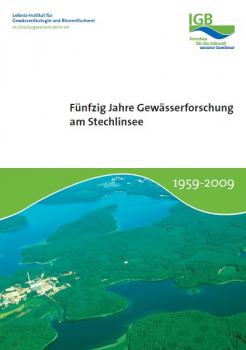
Lake Stechlin is one of the deepest and cleanest lakes in the north of Germany. | © M. Feierabend
The water
Algae and other types of plankton occur at relatively low densities in Lake Stechlin. Nevertheless, the diversity of life (biodiversity) is especially high here. Around 1,200 species have been detected. Together with environmental factors such as temperature and food availability, these organisms determine the relationships in the food web and the cycles of matter in the lake ecosystem.
Also typical of Lake Stechlin, aside from its clarity, is the high oxygen saturation of its deep waters. This promotes rapid degradation of dead biomass in the lower water layers and on the ground – even if the summer stratification (see info box) lasts for a relatively long time. Down in the sediment, however, the oxygen becomes completely used up already in the first few centimetres. Going deeper, fermentation processes dominate and methane gas forms, some of which rises to the surface, where it can escape into the atmosphere.
Lake stratification in summer
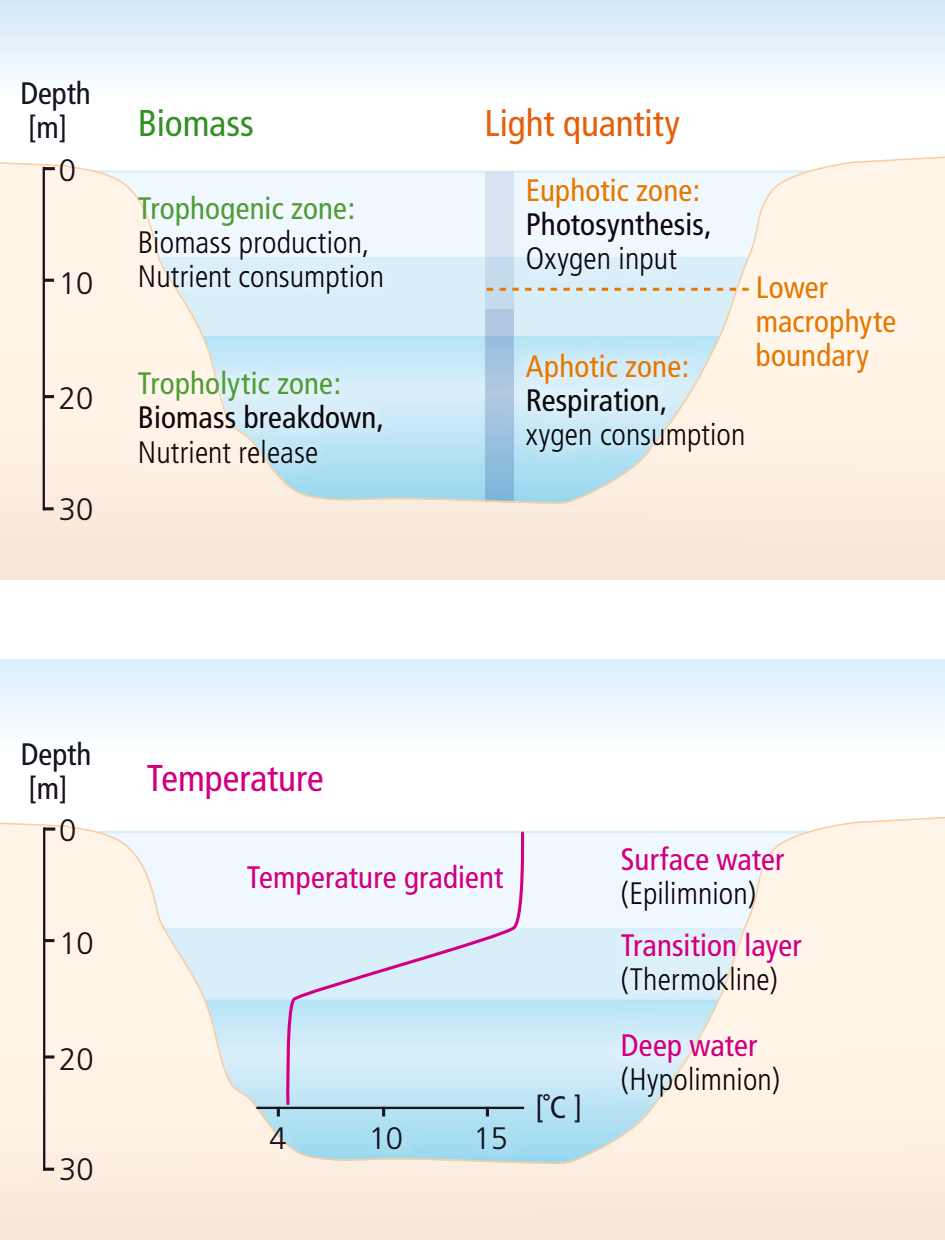
During the summer, in deep lakes such as Lake Stechlin, surface water heated by the sun forms a layer above the permanently cold deep water. This is due to the large temperature-related density differences of the water. Water reaches its highest density at 4 °C, at which point it sinks to the lake ground. Warmer water remains on the surface. In autumn, when the temperature equalizes throughout the entire lake due to cooling at the surface, the wind introduces enough energy of its own to completely mix the upper and lower water masses. This distributes oxygen and nutrients evenly throughout the entire water body so that these elements will be available again for the production and degradation of biomass during the next summer's stratification phase.
Lake Stechlin in figures
- Surface area: 425 ha (4,25 km²)
- Water volume: 97 Mio m³
- Shoreline: 16.1 km
- Average depth: 24 m
- Maximum depth: 69.5 m
- Average depth of visibility in summer: 8.4 m
- Lower aquatic plant boundary: 4-12 m
Life in the lake
Lake Stechlin is a oligotrophic water body. Accordingly, primary production - the production of biomass by photosynthesizing organisms - in the lake's pelagial zone is low. Microscopic species of algae and cyanobacteria (also known as 'blue-green algae') that live suspended in the water collectively constitute what is known as phytoplankton. Phytoplankton represent the most important direct or indirect food source for all other organisms inhabiting the lake, including algae-eating and predatory zooplankton species, as well as aquatic insects, snails, molluscs, and fish. Microorganisms, eminently bacteria and Archaea, break down dead organisms and dissolved organic matter. Thus, mineral nutrients are released and are again available to the lake's primary producers, or autotrophs.
Because of its exceptional water quality, Lake Stechlin is considered a classic 'cisco lake'. The vendace (Coregonus albula) makes up almost 90% of the lake's total fish population. One of Lake Stechlin's characteristic features is the presence of the so-called Fontane-cisco (Coregonus fontanae), a unique species endemic to the lake.
Lake Stechlin's littoral zone is home to extensive populations of different species of aquatic plants like the stoneworts (including Chara globularis) and pondweed. These grow within the upper, sunlit layer of the lake, often several meters below the surface of the water, enriching it with oxygen. Aquatic plants are also the main food source for the many local species of water birds such as the Common teal. By contrast, other water bird species like the Common Goldeneye – the Stechlin/Ruppiner Land National Park's heraldic animal – prey on small animals living in the lake. These shy birds, which breed in hollows of nearshore trees, are seen as a symbol of the intimate interconnection between the lake ecosystem and the surrounding forests.
Focus on plankton
Lake Stechlin is home to more than 200 different species of photosynthetic plankton, as well as countless species of zoo-, bacterio-, and virioplankton. Owing to their great significance for the lake ecosystem, these different species of organisms represent the main focus of IGB's research. Any change in environmental conditions will affect the composition of the lake community and the different processes taking place in the lake. The lake’s organisms are therefore considered important indicators for the state of the ecosystem.
Winners and losers of climate change

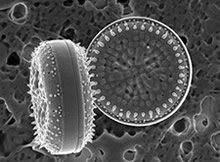
Cyclotella tripartita
Lake Stechlin is home to several rare species of centric diatoms. During the cold seasons, they can make up the majority of the lake's biomass. As such, Stephanocostis chantaicus reaches highest population densities in winter when the lake is frozen over, whereas Cyclotella tripartita dominates the plankton population during the spring. Global warming is a potential threat to both these cold-water species of diatoms.

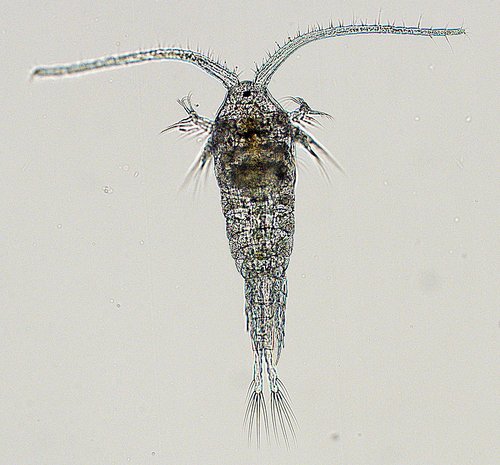
Eurytemora lacustris
Another loser might be the copepod Eurytemora lacustris. This ice age relic prefers cold, deep, oxygen-rich lakes – conditions that can still be found in Lake Stechlin, its southernmost propagation point.

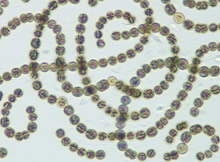
Cyanobakterium Anabaena
The cyanobacterial genus Anabaena may well come out of the climate change debacle as a potential winner. Rising temperatures favour the emergence of cyanobacteria. There is evidence that climate change especially benefits the most toxic species of Anabaena. Cyanobacteria are photosynthesizing organisms. Due to the presence of the blue pigment phycocyanin in this genus of bacteria they are also commonly referred to as 'blue-green algae'.
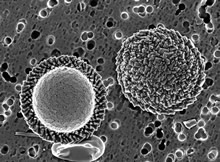

Phacotus lenticularis
The peritrichous green alga Phacotus lenticularis is also a potential beneficiary of climate change. It is most commonly found in bodies of water with a climate-change induced high nutrient content. Because its shell readily absorbs phosphates, which – along with the shell's calcite components – get deposited in the sediment in near-insoluble form following cellular death, Phacotus contributes to nutrient deposition in the sediment. At this time, Phacotus is only very rarely present in Lake Stechlin.
History of the lake
Lake Stechlin's origin is closely associated with the inland glaciation and receding of glaciers at the end of the Weichselian glaciation around 12,000 years ago. Up to 1,000 metres thick, the mighty ice masses in the North German Plain formed a diversified relief of level outwash plains, wavy ground and hilly terminal moraines, along with numerous lake basins.
After the last ice age, Lake Stechlin and the surrounding landscape were initially sculpted by climatic conditions. As time went by, human activities became increasingly influential: Extensive clearing and the construction of artificial inlets and drains have dramatically affected the hydrological regime and thus also the diversity of species in the region.
In the 1930s, Lake Stechlin was placed under protection. Now, an area of more than 8,000 hectares around the lake belong to the Stechlin-Ruppiner Land Natural Park. It is also part of the European Natura-2000 ecological protection network (see info box). Threatened species such as the Hermit Beetle, the Barbastelle bat, the European Otter and the European Pond Turtle are protected here – and their habitats permanently sustained.
Warming by the nuclear power plant
From 1966 to 1990, the Rheinsberg nuclear power plant was operated near to Lake Stechlin. As much as 300 million litres of water flowed each day through its external cooling circuit, taken from the neighbouring Lake Nehmitz. Heated by about 10 degrees Celsius, this cooling water ultimately flowed into Lake Stechlin. To monitor the effects of this heat pollution scientifically, a research institute was founded at Lake Stechlin, and is now a part of IGB. The researchers recorded not only elevated water temperatures down to great depth in Lake Stechlin, but also deteriorated water quality with significant signs of eutrophication.
Even nearly 25 years after this artificial heat pollution stopped, the lake has never returned to its former condition. Since the beginning of the 1990s, for example, the biomass of planktic algae has significantly increased in the lake. Yet, it still cannot be said for sure whether this is a long-term consequence of the power plant operation. The IGB researchers suspect the sediment is releasing elevated amounts of algae-promoting nutrients.
Lakes under climate change
Increased temperatures, decreased rain, altered wind conditions and more frequent extreme events: The exact consequences of climate change on ecosystems are the subject of numerous research projects around the world. Scientists from IGB are studying the effects of climate change on a clear water lake in the northeast of Germany, Lake Stechlin. They expect their findings to yield insights on the consequences for lakes in general. The researchers believe that climate change influences many properties of a lake: thermal stratification, nutrient availability, material turnover rates, diversity and composition of organisms, and concentration of oxygen in the deep water to name a few examples.
Climate change will certainly not spare Lake Stechlin. Over the last 50 years, the surface water has warmed by more than 1.5 °C. This can be seen from long-term measurements. The durations of the thermal stratification phases is also changing: Given warmer winter temperatures, summer stratification now sets in earlier than in previous decades. The scientists have also noted that Lake Stechlin is remaining ice-covered for fewer days in the year. According to model calculations, this trend will continue to amplify until the end of the 21st century, whereupon the winter stratification phase will disappear.
One particularly important factor that defines the character of lakes is their oxygen content. As water temperature increases, the solubility of this gas drops sharply – contrary to what we are familiar with for salt or sugar. At the same time, warmer temperatures accelerate the metabolism of the organisms in the lake resulting in oxygen depletion in the deep water. If algae create more biomass on top of this, then a greater amount of organic material will be available for degradation processes that will use up the oxygen even further. If extreme cases of oxygen-free conditions arise in the depths during the summer stratification phase, then the composition of organisms there will change strikingly. Fish and invertebrates will lose their habitat entirely, and even the composition of microorganisms will shift dramatically.
Nature conservation


Fish school in shallow water. | © M. Feierabend
Around Lake Stechlin, there is a long tradition of natural conservation efforts and nature research. The lake has even been under protection since 1938. After the German reunification, the Stechlin nature reserve expanded to a total area of 8670 ha and is presently the core area of the Stechlin-Ruppiner Land Natural Park. Here thirteen of the 91 Europe-wide endangered habitat types that are listed for Germany in the European Habitats Directive are found. This EU instrument places scientifically defined habitats under special protection in order to conserve threatened species and thus biodiversity. As a result, rare beetles such as the Hermit Beetle, numerous bat and amphibian species, and even the Fontane cisco which occurs only in Lake Stechlin, are under special protection. The European ecological protection network NATURA 2000 additionally lists the region as an EU bird protection area. Among others, threatened birds such as the Great Bittern, the Goosander, the Common Goldeneye and the Osprey benefit from this.
Water conservation is one of the primary aims of the natural park. The EU-Life Project commenced in 2005 for restoring the clear water lakes, moors and bog forests in the Lake Stechlin region has stabilized the hydrological regime and reduced the nutrient pollution. Artificially created drainage ditches have been closed for this purpose, for example. Thus, the amount of drained water has decreased, while the surrounding moors have been refilled with water. Nevertheless, there is still much to be done. Ecological monitoring and continued testing of the water quality of the lakes are helping to detect negative trends and to ensure the long-term conservation of the area by suitable countermeasures. The long-term data collection of the IGB for Lake Stechlin is of immeasurable value to this cause.
The nature reserve management focuses on the sustainable development of the Lake Stechlin region. Its unique nature and landscape are a basis for ecotourism – and must therefore be permanently conserved not only for natural protection but also for economic interests. The nature park shall remain attractive for locals, tourists, friends of nature, photographers and divers. Starting from the NaturParkHaus Stechlin in Menz, the nature park's visitor centre, guided tours and information signs sensitize visitors to the uniqueness and, indeed, the vulnerability of the Lake Stechlin landscape. They call for certain prohibitions in the nature reserve that are unavoidable if we are to preserve the beauty and the value of Lake Stechlin for future generations.




